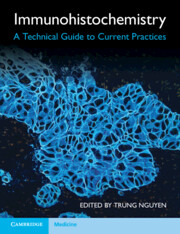Book contents
- Immunohistochemistry
- Immunohistochemistry
- Copyright page
- Dedication
- Contents
- Contributors
- Preface
- Chapter 1 Immunohistochemistry Fundamentals
- Chapter 2 Immunohistochemistry Quality Assurance and Quality Control
- Chapter 3 Automation and Robotics with the Leica Bond III
- Chapter 4 Automation and Robotics with the Roche Ventana BenchMark ULTRA
- Chapter 5 Automation and Robotics with the Agilent Dako Omnis
- Chapter 6 Immunohistochemistry for Research Applications
- Chapter 7 Troubleshooting Immunohistochemistry
- Chapter 8 Current Status of Immunohistochemistry
- Chapter 9 Immunohistochemistry for Future Applications
- Index
- References
Chapter 9 - Immunohistochemistry for Future Applications
Published online by Cambridge University Press: 16 June 2022
- Immunohistochemistry
- Immunohistochemistry
- Copyright page
- Dedication
- Contents
- Contributors
- Preface
- Chapter 1 Immunohistochemistry Fundamentals
- Chapter 2 Immunohistochemistry Quality Assurance and Quality Control
- Chapter 3 Automation and Robotics with the Leica Bond III
- Chapter 4 Automation and Robotics with the Roche Ventana BenchMark ULTRA
- Chapter 5 Automation and Robotics with the Agilent Dako Omnis
- Chapter 6 Immunohistochemistry for Research Applications
- Chapter 7 Troubleshooting Immunohistochemistry
- Chapter 8 Current Status of Immunohistochemistry
- Chapter 9 Immunohistochemistry for Future Applications
- Index
- References
Summary
Immunohistochemistry has progressed from humble beginnings as experimental techniques to what is now considered routine and essential analytical tools. Technologies available today in the research sphere may be adopted for standard practice in the near future. Multiplex assays can help pathology facilities extract more information from less tissue and improved amplification methods may reveal ultra-low expressing proteins that have escaped detection before. New forms of 'tagging' antibodies using nucleotides and quantum dots may replace traditional chromogen and fluorochrome protocols. Next-generation immunohistochemistry enlisting mass spectrometry principles to not only localize antigens in tissue but to also quantify the amount present has real clinical potential. Digital pathology and whole slide imaging have made significant progress to the point of being financially viable. All of these developments are standing at the doorway to the future of immunohistochemistry. Whether they are accepted and implemented in diagnostic laboratories remains to be seen. It is exciting to witness the continuing progression of immunohistochemistry.
Keywords
- Type
- Chapter
- Information
- ImmunohistochemistryA Technical Guide to Current Practices, pp. 253 - 265Publisher: Cambridge University PressPrint publication year: 2022

